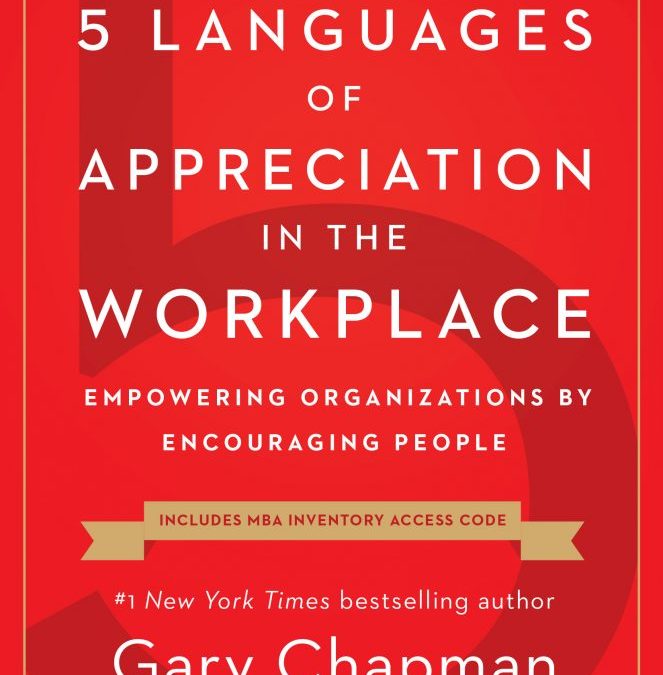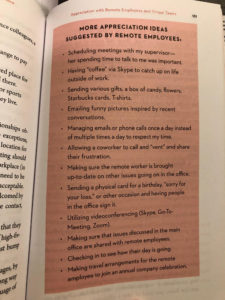Over the past few months, our company has been focused on changing the culture. In fact, I am one of 75 employees who are cultural champions across our organization. Therefore, I have been on a personal mission to seek out methods for maximizing appreciation and value of others. As a result, I recently finished reading the 5 Languages of Appreciation in the Workplace by Gary Chapman and Paul White.
Love Languages: Words of affirmation | Acts of Service | Quality Time | Tangible Gifts | Physical Touch
Let’s break it down further…
WORDS OF AFFIRMATION
Praise for accomplishments: In the workplace, words are the most common form of appreciation. Effective verbal praise is specific. The more you can ‘catch’ a staff person doing a task in the way you want and call attention to that specific task or behavior, the more likely that behavior is going to occur again. For example, “I like the way you answered the phone in a cheerful tone and offered to help the customer resolve their concern” will probably encourage the receptionist to keep answering the phone cheerfully.
Praise for personality: Personality is our normal way of approaching life. When a manager or fellow employee observes positive personality traits and verbally affirms them, you help the individual play to his strengths. For example, “One of the things I admire about you is that you are always optimistic. I sometimes get discouraged, but when I talk with you I always go away with a more positive perspective. I appreciate that.”
Affirmation of character: Positive character traits in those with whom we work – traits such as self discipline, perseverance, honesty, integrity, patience, humility, kindness, and unselfishness – are like jewels that should be highly valued. For example, you might say, “Luis, I really appreciate knowing that you are a man of integrity. I can trust you to deal honestly with our finances. That gives me a great sense of security.” Or you might say, “Christine, you are a really compassionate person. I have observed the way you respond to people who are expressing frustration. You genuinely seek to understand their perspective. I truly admire you for that.”
How and where to affirm? Personal, one-on-one | Praise in front of others | Written affirmation | Public affirmation
Please note that if you are not able to sincerely express affirmation to your colleague at this time, then silence is preferred.
Making it personal:
- Have you received a verbal affirmation from a manager or colleague recently? If so, what did they say? How did you feel?
- Can you recall a time within the past few weeks when you verbally affirmed a coworker? If so, what did you say? How did they respond to your affirmation?
- What type of verbal affirmation impacts you the most? What type do you really not prefer?
- Think of someone who, if they did not do their work, would make your daily work life far more difficult. Specify what you value about what they do, and communicate to them how they make your life at work better.
One of the most important things from reading this book is the need to find out what primary language each individual desires. Without it, you could be thinking you are rewarding something of value but it is actually meaningless to the individual.
Recent actions I have done at work that have proven very meaningful:
- Sent a box of Ms. Field cookies to two of my colleagues and wrote a personal thank you on behalf of our team (tangible gifts + words of affirmation)
- Awarded 2 employees $150 gift certificates for going above and beyond. (tangible gifts)
- Emailed very specific gratitude to certain team members thanking them for helping out (words of affirmation)
- Created a group chat on TEAMS where I weekly invoke some praise or talk about culture
Next steps for me is to create a simple survey for our architectural technical sales team and dive deep into which of the languages is most important to them and tailor our appreciation towards that. As 90% of our team is remote, this adds a new dimension on how to make them feel valued and a part of the company. One immediate thing I wanted to do this summer was send them some ice cream, since they always miss out on the ice cream socials at our headquarters.
Here’s a list that the book suggests for appreciation for remote employees:
What are you doing for your team? Please leave a comment and share.


